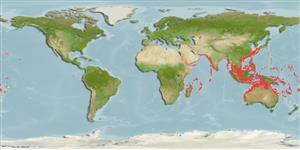>
Eupercaria/misc (Various families in series Eupercaria) >
Lutjanidae (Snappers) > Apsilinae
Etymology: Paracaesio: Greek, para = the side of + Latin, caesium = bluish grey (Ref. 45335).
More on author: Bleeker.
Environment: milieu / climate zone / depth range / distribution range
Ekologi
laut berasosiasi dengan karang; kisaran kedalaman 5 - 250 m (Ref. 86942). Tropical; 35°N - 35°S, 37°E - 169°W (Ref. 55)
Indo-Pacific: East Africa to the Austral Islands, north to southern Japan, south to southeastern Australia. Paracaesio xanthura, a complex of variable populations, may compose a single or two (or more) species. Paracaesio pedleyi, from Lord Howe Island, Middleton Reef, and eastern Australian waters, is included here with some reservation (Ref. 9821).
Size / Weight / umur
Maturity: Lm ? range ? - ? cm
Max length : 50.0 cm TL jantan/; (Ref. 5484)
Duri punggung (Keseluruhan (total)): 10; duri punggung lunak (Keseluruhan (total)): 10-11; Duri dubur 3; Sirip dubur lunak: 8 - 9. This species is distinguished by the following characters: body relatively deep and laterally compressed, greatest body depth 2.5-2.8 in SL; interorbital region convex; mouth terminal, jaws about equal; anterior end of upper lip without a thick fleshy protrusion; maxilla with or without scales and without longitudinal ridges; teeth in jaws caniniform to villiform; gill rakers of first gill arch 5-11 + 18-20; soft rays of dorsal fin usually 10, in anal fin 8; lateral line scales 70-72; caudal fin forked. Colour bright blue; broad yellow band over most of dorsal half of body, including most of caudal pedincle fin (Ref. 9821, 90102).
Adults occur over rocky bottoms, sometimes forming large schools. They feed largely on zooplankton (Ref. 30573). Caught mainly with handlines and bottom longlines and marketed fresh or frozen (Ref. 9821).
Life cycle and mating behavior
Kematangan | Reproduksi, perkembang biakan | Pemijahan | telur-telur | Fecundity | Larva
Allen, G.R., 1985. FAO Species Catalogue. Vol. 6. Snappers of the world. An annotated and illustrated catalogue of lutjanid species known to date. FAO Fish. Synop. 125(6):208 p. Rome: FAO. (Ref. 55)
Status IUCN Red List (Ref. 130435)
ancaman kepada manusia
Harmless
penggunaan manusia
Perikanan: komersial
informasi lanjut
Nama-nama umumSinonim (persamaan)metabolismePemangsaEkotoksikologiReproduksi, perkembang biakanKematanganPemijahanSpawning aggregationFecunditytelur-telurpekembangan telor
AcuanBudidaya airprofil budidaya airStrainGenetikaElectrophoresesDiturunkanPenyakit-penyakitPengolahanNutrientsMass conversion
mitraGambarStamps, Coins Misc.Suara-suaraCiguateraKecepatanTipe renangArea insangOtolithsOtakPenglihatan / visi
Alat, peralatan
laporan khas
muat turun XML
Sumber internet
Estimates based on models
Preferred temperature (Ref.
123201): 19.9 - 28.3, mean 26.5 °C (based on 1214 cells).
Phylogenetic diversity index (Ref.
82804): PD
50 = 0.5039 [Uniqueness, from 0.5 = low to 2.0 = high].
Bayesian length-weight: a=0.01905 (0.01031 - 0.03520), b=3.08 (2.91 - 3.25), in cm total length, based on LWR estimates for this species & (Sub)family-body (Ref.
93245).
Trophic level (Ref.
69278): 3.4 ±0.45 se; based on food items.
Daya lenting (Ref.
120179): sedang, Waktu penggandaan populasi minimum 1.4 - 4.4 tahun (Preliminary K or Fecundity.).
Fishing Vulnerability (Ref.
59153): Moderate vulnerability (40 of 100).
Nutrients (Ref.
124155): Calcium = 35.2 [20.5, 63.3] mg/100g; Iron = 0.611 [0.323, 0.987] mg/100g; Protein = 18.6 [16.7, 20.3] %; Omega3 = 0.152 [0.096, 0.241] g/100g; Selenium = 46.7 [28.3, 84.0] μg/100g; VitaminA = 105 [37, 345] μg/100g; Zinc = 0.993 [0.700, 1.369] mg/100g (wet weight);
